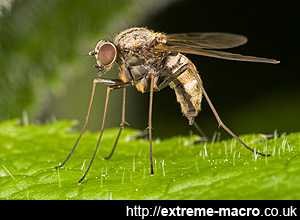Extreme Macro Techniques
by Johan J Ingles-Le Nobel
Last updated August 31, 2017
Contrary to popular opinion, there really is no mystery to extreme macro. Anyone can do it, it doesn't have to be expensive and it's a great way to do simple wildlife photography in the back of your garden.
Extreme macro can be done in the studio during winter and it can be done at night. Extreme macro can be done with add-on adapters or reversed lenses. Extreme macro is fun to learn and opens a whole new world of macro photography.
Several Techniques
Although there is a bewildering amount of different equipment used to shoot an extreme macro photo, in terms of achieving a final shot there are really only two broad techniques that we use: either we use macro stacking or we do a single shot.
start out with Raynox (or other achromatic) adapters at firstFrom personal experience, I'd recommend to start out with Raynox (or other achromatic) adapters at first. Adapters get you to about 3:1 or so. A decent achromatic adapter has good image quality, doesn't cost more than £100 and has the great benefit of letting you use in-camera aperture setting, metering and autofocus.
Reversing lenses is another popular way to start out in extreme macro, but using this technique is significantly more challenging because of the lack of transmitted aperture information.
Focus Stacking
Focus Stacking Walkthrough
1 ➤ The focus stacking workflow
2 ➤ How to prepare a focus stack
3 ➤ How to shoot a focus stack
4 ➤ Software tools for focus stacks
5 ➤ Postprocessing tools for focus stacking
Focus stacking takes photographs at different focus points and adds them to make a final composite 'all in focus' image. Stacking is a relatively new development in photography and was only made possible by the advent of digital photography, and the ability to add photographic images on a computer using software.
Stacking is necessary because it overcomes the depth of field limitations in traditional photography. The laws of physics dictate the maximum depth of field for any photo and unless stacking is used, it is physically impossible to show a sharp and detailed extreme macro image at a reasonable resolution.
There are various stages in the focus stacking workflow each of which merit some separate discussion: preparation for the focus stack, shooting the focus stack, processing your focus stack and postprocessing the focus stack.
Focus Stacking: Increasingly Popular
Focus stacking is no longer the preserve of people with specialised high-end equipment and is increasingly adopted in mainstream photography. It is surely only a matter of time before the main camera brands start to include simple stacking inside digital cameras, and in fact there is already a stacking functionality inside the open source magic lantern firmware for Canon and the latest Nikon has lens-based focus stacking functionality in the camera.
Extreme Macro with a Reverse Lens

Single shot macro using a ringflash. Ringflashes get a bad rap for having boring, uninteresting and undimensional flat lighting, but a sophisticated ringflash in the hands of a good photographer will give very bright, sparkly lighting that creates a great deal of pop. But, this is also largely due to choosing the right subject - this snipe fly has no metallic parts and doesn't reflect light, so there are no flash reflections that could spoil the pic.
Extreme macro does not have to be stacked and there is a fine tradition of extreme macro photography using flash and macro lens. Whilst this used to be the domain of folks with bellows and expensive lenses in the field, the advent of APSC photography has led to a glut of old 35mm SLR lenses on the market that can easily be used to start extreme macro on a budget, be it through reversed lenses, reversed enlarger lenses or even microscope objectives.
Technology advances in high ISO cameras and lighting, coupled with the global marketplace means that there are now more accessories available to anyone than ever before, with a cost of learning with digital photography is a fraction of what it used to be.
First Step
If you have a DSLR camera and are keen to get into the world of extreme macro, your first step should be to use Raynox closeup lenses on your existing kit zoom. Using a supplementary lens like a Raynox on a zoom will not only give you variable magnification, but let you meter and set aperture through your camera.
Related Articles





